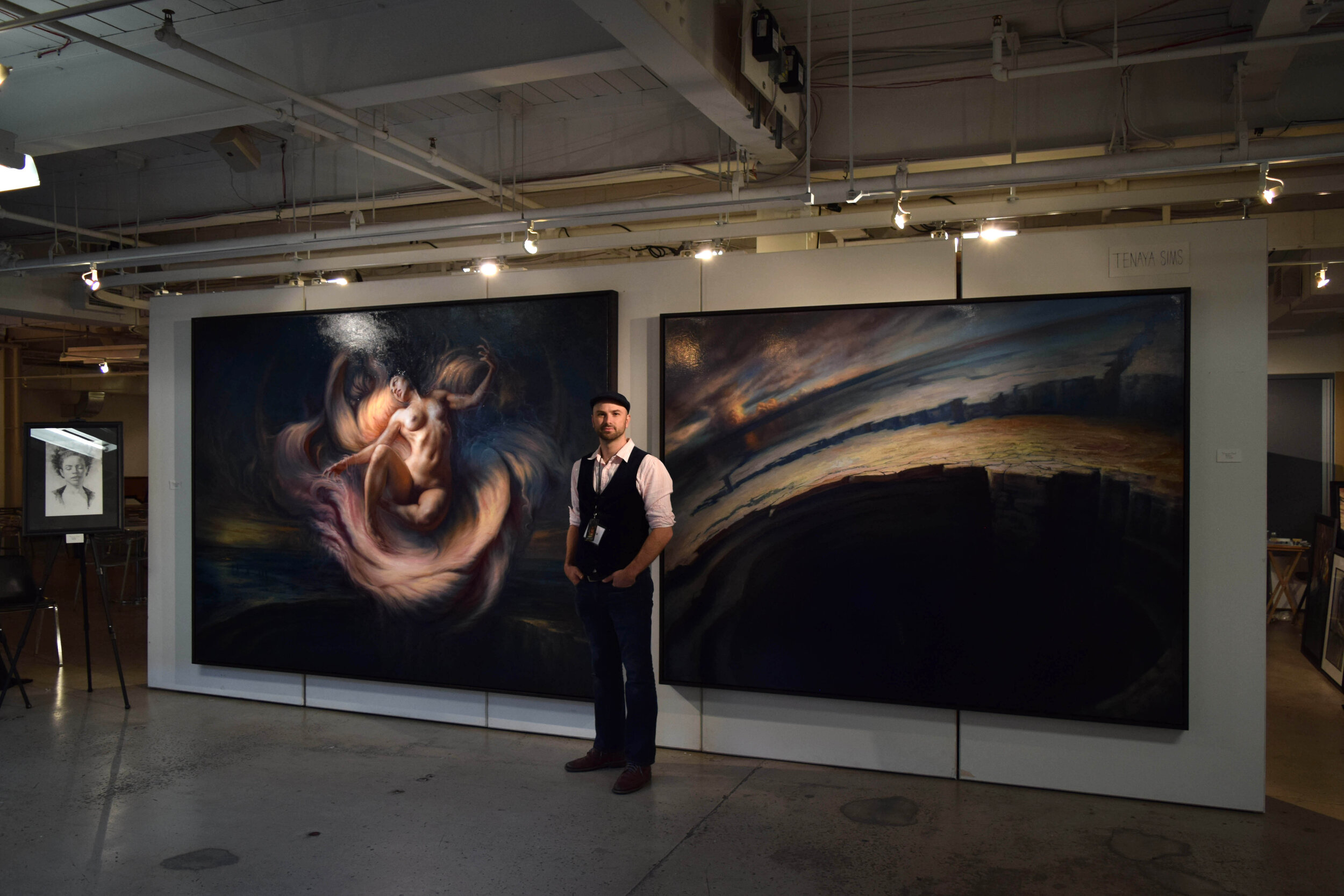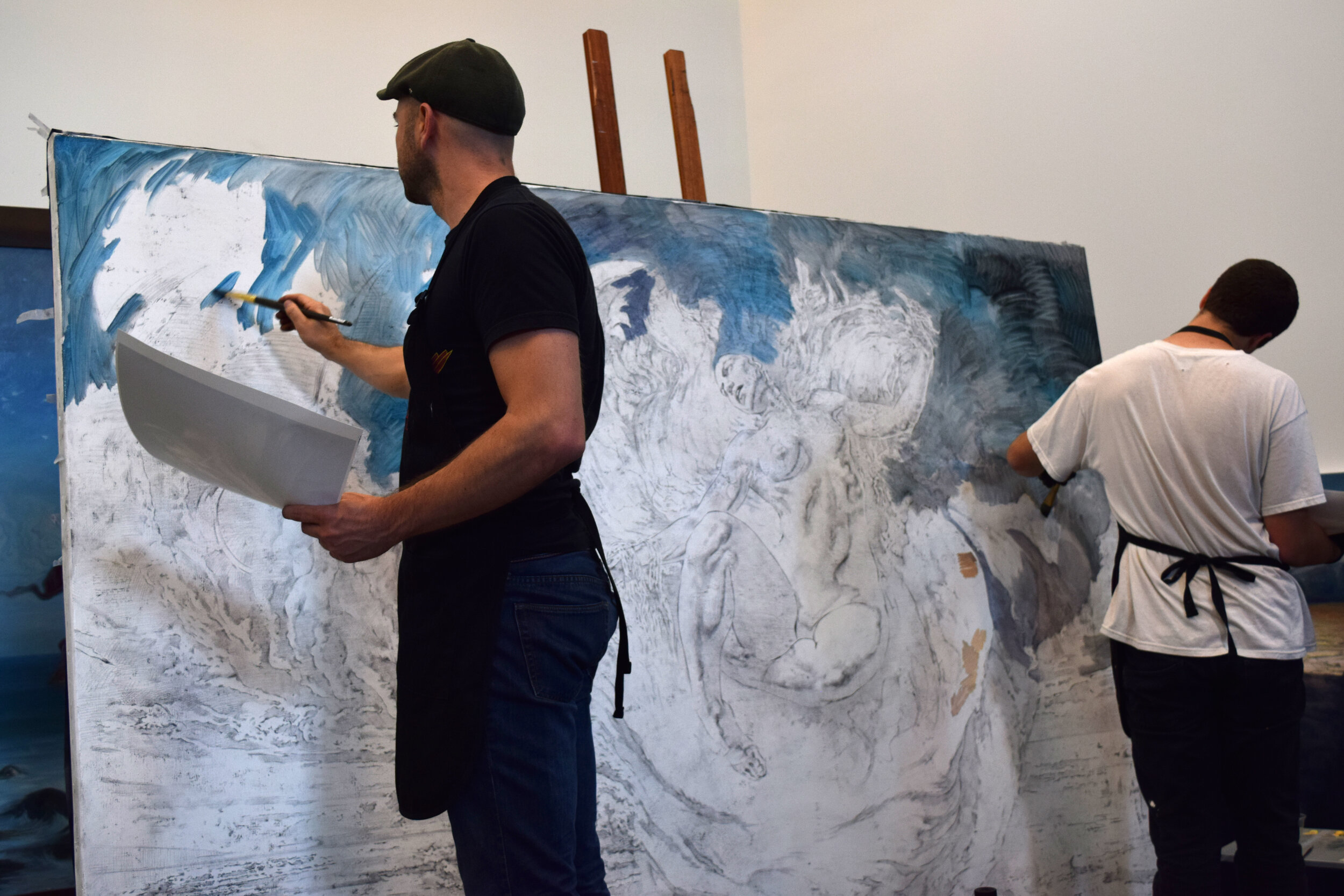The Development of Anthesis
Anthesis and Basin were originally conceived as the same composition, but as the sketch developed, they divided into two projects. In retrospect, I realized that this division occurred in tandem with the birth of my daughter. It was as if the paintings also arrived through a form of cell division from an initial ‘zygote’ sketch.
The meaning of Anthesis: ‘the action or period of opening of a flower’.
Idea Nucleus
This sketch demonstrates the initial imagining of the floating figure in an abstracted watery landscape, where compositional elements orbited the pregnant sphere.
Refined Nucleus Drawing
As I gathered reference, I was beginning to refine the initial sketch.
Color Study
I then made a print of the drawing and painted this color study over the top with oils.
Finished Mini-Painting
I completed a small version of the painting on a 9” x 12” canvas and presented it for a small works show.
Ideation for the Large-Scale Project
Wanting to do a large-scale version on this theme, I returned to the sketch book with the idea of fashioning it into a horizontal composition. I had recently been on an airplane flight and took a series of experimental photographs from the window. I used the panorama feature and tilted the camera. This exaggerated the curved horizon of the earth. I was contemplating on the sphere; as both seeds and planets, and thought by exaggerating the horizon it might remind the viewer of the spherical shape of planet, and help tie the two together.
Figure/Landscape ‘Cell Division’
Scanning the drawing into Photoshop, I began experimenting with the figure/landscape relationship. I retrieved a reference of a quarry and noticed the way it appeared like a spiraling canyon into the earth. I tried extending that spiral so it would further spread throughout the landscape. Finally, I attempted to carve the whole matter out, forming a massive circular abyss.
While I liked these new developments in the landscape, I was finding the surroundings increasingly separate from the figure. It felt as if the landscape wanted to be its own creation. Thus, I decided to divide the concept into two projects: The curved horizon landscape became ‘Basin’ and the figurative version ‘Anthesis’.
Ideation for the Large-Scale Project
Wanting to do a large-scale version on this theme, I returned to the sketch book with the idea of fashioning it into a horizontal composition. I had recently been on an airplane flight and took a series of experimental photographs from the window. I used the panorama feature and tilted the camera. This exaggerated the curved horizon of the earth. I was contemplating on the sphere; as both seeds and planets, and thought by exaggerating the horizon it might remind the viewer of the spherical shape of planet, and help tie the two together.
Rolling Clouds
Returning to a more traditional landscape orientation, I began experimenting with merging the swirling ‘flower petals’ surrounding the figure with rolling storm clouds.
Rolling Storm Thumbnail Drawing
I liked the general direction of the storm-clouds being generated by the figure. My attention began to wane from working digitally, so I decided to shift the energy into a sketched thumbnail drawing. This change ended up paving the way for the rest of the piece.
Expanded Thumbnail Drawing
This picture represents a more developed version of the thumbnail sketch. You can notice how some of the ‘flower petal’ elements begin to further extend into the storm clouds.
Color Experiment
My next step was to scan the thumbnail drawing into photoshop. I made an initial color overpainting and also did some ‘photo bashing’.
Basin Returns
I hollowed out the circular body of water from the previous study and ‘reintroduced’ Basin back into the landscape. Is this the same landscape as Basin but at a vastly different point in time? Did life spring out of Basin or is Basin in the future after life has departed? I wondered about these questions.
Flowers Reach into the Clouds
Here, you can notice how I begin to further integrate the ‘flower petal’ shapes and rhythms into the sky.
Original Anthesis Variant
I attempted to have the composition revolve around the pregnant belly/sphere, but ultimately decided against this variation. My vision was to embed and suggest the elements of birth rather than to directly symbolize it.
Rebalanced Composition/Final Prototype
My original plan was to make the piece more widely horizontal, but finding a way to balance the composition became problematic. Thus, I shifted the figure to the left and cropped in on the side. I was experiencing a lot of pressure to finish the painting in time for my first showing at IX, so decided to move forward to the final painting. In hindsight, I wish more time was spent refining the figure. I left too much unresolved, particularly regarding the legs. Having to problem-solve this in the actual painting turned out to be a giant problem.
The Transfer Begins
Checking the Transfer Lines
The Transfer as Seen from the Loft
The Finished Transfer
Transfer Detail
The Wash-In
To expedite the completion of the piece, I hired co-teacher Riley Doyle to work on this stage of the project with me.
Beginning the Environment
My plan was to begin working on the environment before getting to the figure. Usually this is a sound approach, but in hindsight I wish I had done the reverse. Because I was in such a time crunch towards the end of the project, I needed to execute the most important areas of the painting in haste.
Painting the Hand
I painted the hand along with the environment because in this area it is particularly important to achieve wet-into-wet blending of edgework. Certain effects in oil painting can only be achieved while the paint is still elastic, making it critical to plan accordingly.
Finishing the Environment
Working on Anthesis with Basin Nearby
Painting the Head
This demonstrates how the paint is first applied in distinct ‘tiles’ and then softened along the axes of the form.
After painting this initial pass, it became apparent that the legs weren’t working anatomically. I was trying to fold the legs to echo the spiraling rhythms of the composition. But, in doing so, I bent some anatomical rules too far. With little time left to finish the painting, I scrambled to correct this.
Another issue added to the challenge. Because classes were scheduled to soon begin, I also needed to move the painting out of the large studio into a smaller studio space. This took away the ability to back up from the painting and gain necessary perspective.
I repainted the legs in a frenzy. While I thought it improved some of the anatomical issues, I also felt these changes disrupted its compositional flow. I wasn’t satisfied by the outcome, but it was too late to make any additional changes.
This picture shows the painting taken off the stretchers before loosely rolling it and placing it into the crate.
Off it goes!
To roll the painting up to ship back to Seattle, my generous students stepped in to help.
Going Back to the Legs Once Again
After returning from IX, I reassembled the stretcher and remounted the painting on it. I gathered additional reference and drew a new version of the legs. I wanted to recapture the original rhythms without overly distorting the anatomy. While I was happy with the drawing, it seemed that every time I tried to paint the legs, somehow or another they didn’t appear spot-on.
Unending leg corrections
Sucked into a vortex where nothing looked quite right, I sanded down the painting, re-transferred it, and repainted the legs—not one but two more times. The previous two versions can be seen as ghosted images (where it was sanded down), before being covered up.
The Final Painting
There is still one *final* leg variation (that extends down more vertically) that I might experiment with, and perhaps get sucked back into the black hole of perfectionism.



